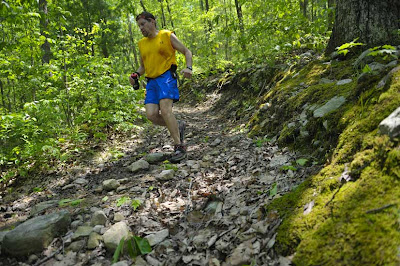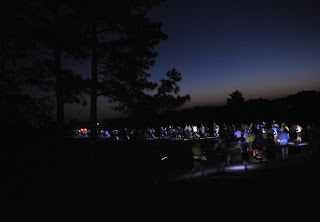Tom Sperduto should need no introduction, after all, we introduced him yesterday. Anyway, Tom is an award winning portrait photographer and ultramarathoner, who has kindly agreed to share 10 trail running photography tips with us. What’s more, Tom has agreed to answer some iRunFar reader trail photography questions. Therefore, if after reading Tom’s tips you still have some questions, please leave it as a comment before Friday and Tom might answer it in a follow up post. Without further delay, here are Tom’s trail running photography tips.
10 Trail Running Photography Tips
1) Choosing a camera for the trail
I have photographed both the Boston Marathon and the JFK 50 while running. I decided to try different cameras for both races.For the Boston Marathon I chose a Nikon S550 because of the size (it fits in the palm of your hand) and its exceptional picture quality. I chose the Panasonic LX3 for the JFK 50 and though this camera is a bit bigger the image quality was the deciding factor for this choice. As I train for and plan ahead to photograph my first 100 miler while on the run, I am considering a more rugged camera and I look forward to testing the new Panasonic DMC-TS1 which will be released in April. This camera is waterproof, shock proof and dust proof. It also is expected to deliver really great video which can be a lot of fun on the trail also.
I am a firm believer that it’s the photographer who makes the picture and not the camera. My favorite trail camera, though a bit bulky, is a $40 plastic film camera called a Holga. It offers a nostalgic feel in medium format black and white film.
2) Keep your camera close to you
This is an important lesson I learned on my long runs training for the JFK 50. If I put my camera in the back of my hydration pack, I would come home with a lot fewer pictures. I purposely chose the WASP hydration pack because of the excellent front pockets and the quick accessibility to a camera. I am envious of those runners who have the old version Nathan HPL #20 (iRF review) since the front chest pouch looks perfect for a camera. I have been extremely pleased with the WASP as both a hydration pack and as a place to carry my camera on the run.
Bottom line: if your camera is easy to reach you will use it. If it’s not, you won’t.
3) Changing your angle will often yield better pictures
If you are like me and enjoy photographing other runners while they zip by you on the trail remember that a different angle will often give you better pictures. I am always looking for a lower or higher angle to give my photos a different perspective than what we see at eye level. We live our lives at eye level, often getting lower or higher will make things more interesting.
4) Fill your frame, control your background
As a photography instructor, time and time again I have seen this to be the most difficult aspect to master. This one takes practice. Simply put, hit the shutter when you have everything in the frame you want and nothing else. Pictures can often be improved simply by stepping closer, left or right. If the tree is growing out of your buddies head, move until it’s not.
5) Keep an eye on the light
Light is as important to your pictures as hydration is during an ultra. Remember when light is the best, morning and late afternoon, this is when your pictures will be best. I rarely, if ever, use a flash when photographing on the run.
6) Charge your battery and if you shoot a lot bring a spare
Yes, this sounds like common sense but the next time wouldn’t be the first time I clicked the shutter only to learn that my battery is still on the charger. Make your camera preparation part of your trail prep check list.
7) Have a big enough memory card to keep you shooting
The price of high capacity memory cards has really dropped and they will keep you shooting. Having no space on your card is one of the quickest ways to miss the next great picture.
8) Read your manual and understand the functions of your camera
As a professional photographer, I am asked on almost a daily basis to “set” someones camera or explain a function. The better you understand your camera and its abilities and limitations, the better your pictures and the quicker you will get them.
(2008 JFK 50 – click to enlarge)
9) Sometimes “P” mode IS for professional
There is a an age old joke shared among professional photographers that the “P” or Program mode is for professional. Every photographer who makes a living with a camera knows that doing things manually lets you control the outcome of your picture often resulting in much better images. However, I rarely ever shoot manual when shooting on the run. Today’s cameras are so advanced that the “P” mode or “A” mode or “S” mode will give you great results and get you back to running quicker … if you decided to stop at all. I do recommend understanding all of your “automatic” settings and practicing and learning what works best in what situation.
10) The best train
ing in taking great pictures is looking at great pictures
So you have decided you want to take your trail running photos to the next level. The best place to begin is by understanding what makes great pictures. For me it’s simple – Light, Color, Gesture. I use these three as a barometer for every picture I shoot and everyone that I look at. Light creates mood and drama, Color is not simply a color photograph it’s when the picture is dependent on the color or not. Gesture is the reason for the photograph, it’s what made you stop and take out the camera. Gesture can be the sweat or anguish on a tired runners face or the smile of a long race accomplished. Gesture can be the single lonely flower surrounded by mud and trees or it can be a sunrise you always want to remember. Gesture is the reason for the photo.
Remember to leave a comment before Friday if you have a trail running photography question for Tom.



